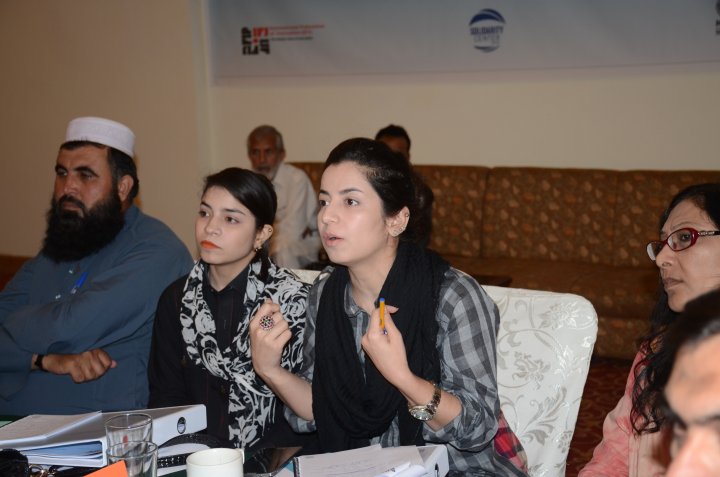
Following the launch of a recent series of Solidarity Center workshops that covered safety as well as gender equality, more than 60 journalists from around 15 local unions in Pakistan came away with the resources and information they need to better protect themselves against physical danger, online threats and gender discrimination and harassment.
“Journalists in Khyber Pakhtunkhwa (in northwest Pakistan) are facing a lot of problems, especially female journalists, who face many issues in the field as well as in their offices,” says Samina Naz, a reporter for Radio Pakistan. “This training has broadened and clarified the concept of safety for me. Now I am more careful about my safety when I go to cover any story.”
Naz, who plans to share the techniques she learned with her colleagues, took part in the two-day training, Gender Equity & Physical Safety. The October workshop was the first in a series planned by the Solidarity Center in conjunction with the Pakistan-based Journalists for Democracy and Human Rights (JDHR) and the International Federation of Journalists (IFJ).
‘We’re Also Workers. What about Our Rights?
A second workshop in October covered physical safety and digital security. Dara Zafar, vice chairman of the All Pakistan Newspaper Employees Confederation-Karachi chapter and a layout assistant at The News International, took part and says he intends to “be more cautious about his physical safety and digital security” and noted he had previously received no training on security issues.
In fact, nearly all participants surveyed prior to the trainings said their organizations do not provide security assessment or analysis. Further, they said neither they nor their organizations had made safety plans for reporting in the field or working online.
Nighat Rafaq, Solidarity Center monitoring, evaluation and reporting manager for Pakistan, says the Solidarity Center developed a two-year training and development program after journalists asked: “We’re also workers. What about our rights? Who will talk about our rights?
“Previously, there were a lot of opportunities for journalists, but on their professional side—for example, improving reporting skills—but not on their rights as workers,” she says.
In 2002, Pakistan legalized private media ownership, which previously had been state owned. The action sparked a surge of electronic and print news outlets, and the number of journalists in Pakistan increased from 2,000 to more than 18,000 today, while the number of other media industry workers skyrocketed from 7,000 to more than 300,000.
“The rapid growth in the industry has been accompanied by a decrease in respect for journalists’ basic labour rights, including fair wages, decent employment conditions, trade union rights and physical safety on the job,” says Immad Ashraf, Solidarity Center program manager in Pakistan.
At least 70 journalists have been killed in Pakistan since 2002, 14 of whom were murdered last year, leading the International Federation Journalists to name Pakistan as the most dangerous country for journalists.
Safety Trainings Set for Hundreds More Media Workers
Following the workshops, participants report being able to develop a safety plan and utilize survival tips when working in difficult environments. Nearly 80 percent say they now will be able to conduct security assessments and analyse a potentially dangerous situation for themselves and their colleagues before jumping into an assignment, and 86 percent report increased knowledge about their digital security-related vulnerabilities.
The Solidarity Center worked with the IFJ to develop a train-the-trainer manual for participants, so journalists can share tactics and knowledge with their colleagues. Similarly, another manual on gender equity and physical safety for women journalists and media workers also has been developed. The Solidarity Center will hold dozens more trainings in coming months, including workshops on paralegal education for 120 journalists and union leaders, and 14 two-day follow-up trainings for at least 340 journalists and other media workers.
Along with its allies, the Solidarity Center also will convene five one-day dialogue sessions for 250 representatives of journalists’ and media workers’ unions, media organizations and government agencies to discuss improving laws and policies on working conditions in the media sector. Another goal is to establish a legal fund to support individual and collective legal cases with potential to impact worker rights, working conditions and the physical security of journalists and media workers.
In Pakistan, where journalists often report on human rights issues, media professionals now have the opportunity to focus on their own human rights as workers. Siddiq Anzar, chairman of the Islamabad & Rawalpindi chapter of All Pakistan Newspaper Employees Confederation and president of Islam Press and Workers Union, put it this way: “After the training and having been exposed to the content and techniques, I now feel empowered.”
Source: http://www.solidaritycenter.org/pakistan-journalists-assert-human-rights-worker-rights/

